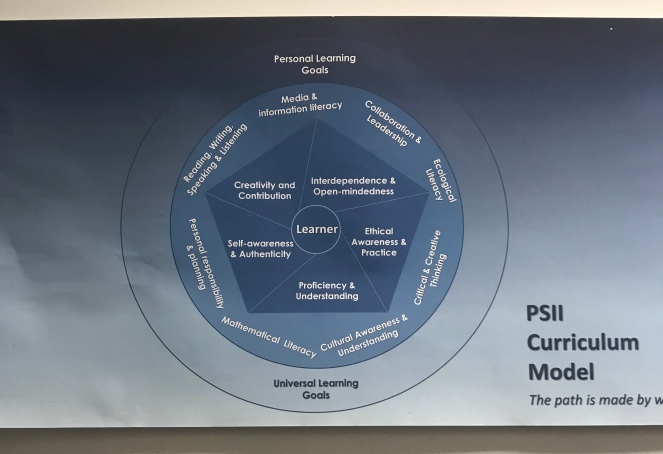This week we had the opportunity to visit the Pacific School for Innovation and Inquiry during class time. This is a high school in Victoria that is completely inquiry and innovation based. As inquiry is something that is discussed and encouraged loads throughout our classes, I found this experience to be very eye-opening.
This school is quite small and does not even looking like a typical school that I am used to seeing. There are 85 students who attend the school and 5 teachers. It was actually in a space that was an office building but they have managed to make it work quite well as a school.
We were welcomed into the school and given an introduction to the whole idea by the principal. He explained to us that this whole school was based on research and that the majority of the students were thriving in this school environment. The students mainly pose inquiry questions and then facilitate their own learning to solve and answer these questions, all while the teachers connect it back to the BC curriculum. Some of the projects that we were able to observe students working on were very interesting because they were not the types of projects that you would generally expect to see in a high school environment.

I had a lot of questions going into this school and feel like I came out with some answers and then some further questions. The principal and those who are very in favour of this school continued to say that this model would work for everyone. I am not 100% certain about that. I think that often times students need more structure and support than just being left to their devices. I didn’t really understand how the students would learn subjects like math and physics concepts through just straight inquiry, especially for things like calculus. I also wondered about accountability for the students in terms of checking in with teachers but it seemed like the school had a good system for organizing various teachers to check-in with various students. Something that I noted was that because it was such a small school, there were no sports teams. For myself, I consider playing sports to have been an integral part of my high school experience, but I recognize that this is often what comes with having a much smaller school. The principal did note that the students have fitness plans and are spending time working on their physical fitness at a local gym and sports center that is close to their school.
I really liked how each learner was viewed as an individual and therefore their day was catered to them. When I was in high school, I often felt as though I was just being pushed along through the process by teachers who didn’t really know me or care about me. I often felt like I was not given enough independence and that my teachers did not trust me, as I was a teenager. I noticed at PSII that there is loads of autonomy given to students and they are ultimately responsible for their own education. I found myself wishing that I was also given these opportunities while I was still in public school.
I still am unsure if this exact model would work in a primary elementary school type of classroom. I could just be being naive or just processing what I have been fed through my traditional public education, but I really don’t know if 7-year-old students would genuinely learn all the things in the curriculum if they were just left to their own devices throughout the day. With subjects such as reading and writing, I see how this could be practised through inquiry but at some point, I feel like the students may require some direct instruction.
Overall, I feel like my mind was opened up to a whole new way of teaching and I am interested to visit an inquiry-based elementary school classroom in the near future to further understand how this can be put in place with younger children.

